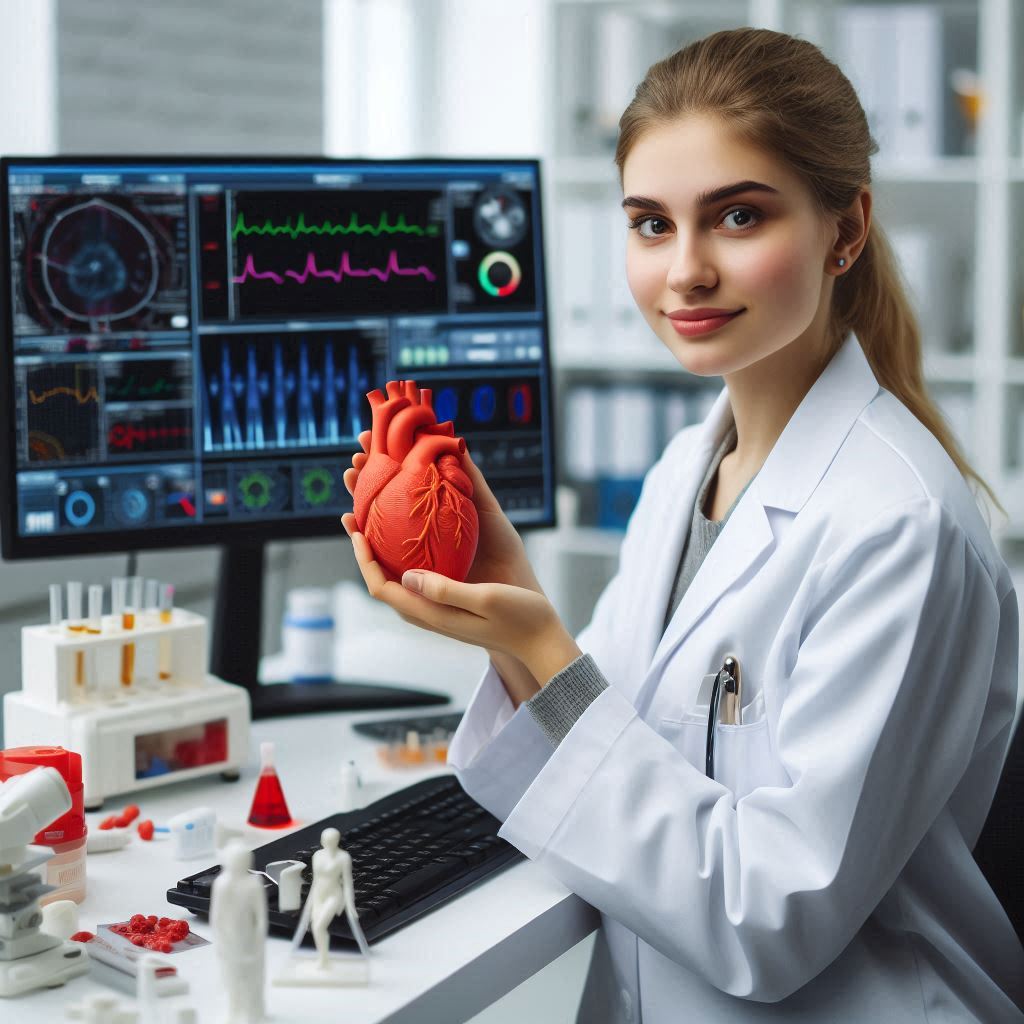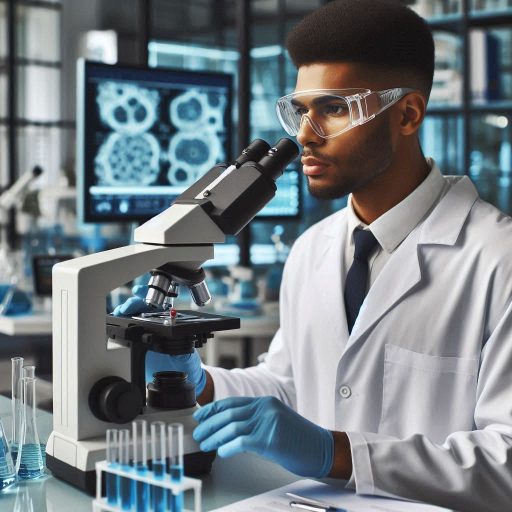Introduction
Biomedical engineering combines engineering principles with medical sciences.
It aims to improve healthcare through innovative solutions.
This discipline focuses on developing technologies that enhance patient care and treatment outcomes.
Biomedical engineers work on various projects, from medical devices to tissue engineering.
One significant advancement in this field is the development of artificial organs.
Artificial organs are man-made devices designed to replace or enhance the function of natural organs.
They can restore vital functions in patients suffering from organ failure or damage.
Examples include artificial hearts, kidneys, and lungs.
These devices help maintain or improve patients’ quality of life.
The creation of artificial organs involves various engineering disciplines, including mechanical, electrical, and materials engineering.
Biomedical engineers collaborate with medical professionals to design and test these devices.
They ensure that artificial organs are safe, effective, and compatible with the human body.
Advances in technology, such as 3D printing and biocompatible materials, have accelerated the development of artificial organs.
Researchers are now exploring the use of stem cells and regenerative medicine to create functional organs.
This innovative approach holds the promise of addressing organ shortages and improving transplant outcomes.
In summary, biomedical engineering plays a crucial role in developing artificial organs.
This field continues to evolve, driving advancements that enhance patient care and healthcare technologies.
History of Biomedical Engineering
Beginnings of the Field
Biomedical engineering is a fascinating blend of medicine and engineering.
Its roots trace back to ancient times when healers used mechanical devices for treatment.
Early Egyptians crafted splints for broken bones, while Greeks developed surgical tools.
These primitive practices laid the foundation for future advancements in the field.
In the 19th century, significant developments marked the progression of biomedical engineering.
One notable milestone was the invention of the stethoscope by Ren‘ Laennec in 1816.
This tool transformed how physicians diagnosed patients, allowing for non-invasive examinations.
Shortly after, in 1846, anesthesia emerged, revolutionizing surgery.
The ability to manage pain opened doors for more complex procedures.
Milestones and Advancements in the Industry
The 20th century witnessed rapid advancements in technology.
The introduction of X-rays in 1895 by Wilhelm Conrad R‘ntgen revolutionized medical imaging.
This technology allowed doctors to see inside the human body without surgery.
The subsequent development of ultrasound in the 1950s further improved diagnostic capabilities, providing real-time imaging for prenatal care and other medical applications.
In the 1960s, the field began to mature as universities started offering formal programs in biomedical engineering.
This move institutionalized the discipline and encouraged research and innovation.
It also created a pathway for engineers and medical professionals to collaborate closely.
This collaboration became essential for designing medical devices and improving patient care.
The development of artificial organs began to gain momentum in the latter half of the 20th century.
The first successful heart valve replacement surgery occurred in 1960, demonstrating the potential of biomedical engineering.
In 1982, the first artificial heart, the Jarvik-7, was implanted in a human.
This groundbreaking event captured global attention and showcased the possibilities of artificial organ development.
As technology progressed, so did the complexity of biomedical devices.
In the 1990s, researchers developed biocompatible materials for implants.
These materials significantly reduced the risk of rejection by the human body.
Furthermore, the integration of computer technology into medical devices enhanced monitoring and diagnostics.
The new millennium brought exciting innovations, such as 3D printing of organs and tissues.
Researchers began exploring bio-printing techniques, enabling the creation of personalized implants.
This technology holds the promise of revolutionizing transplantation and reducing organ shortages.
Today, biomedical engineering continues to evolve rapidly.
Researchers are developing advanced prosthetics that integrate with the nervous system.
These devices offer improved functionality and a better quality of life for amputees.
In review, the history of biomedical engineering reveals a journey of innovation and collaboration.
From early mechanical devices to cutting-edge artificial organs, the field has transformed healthcare.
The future holds even more promise as technology advances, improving patient outcomes and extending life.
Read: U.S. Cities with the Most Opportunities for Environmental Scientists
Importance of Artificial Organs
Addressing organ donor shortage
Artificial organs play a critical role in modern medicine.
They help address the persistent shortage of organ donors.
According to the World Health Organization, millions of patients worldwide wait for organ transplants.
The demand often exceeds the supply, leading to dire consequences.
Patients can face long wait times, worsening health, and increased mortality rates.
Artificial organs provide a solution to this pressing issue.
They offer hope to patients who might otherwise have no options.
With advancements in technology, we can create artificial organs that mimic the function of natural ones.
These innovations can significantly reduce the strain on traditional organ donation systems.
By using artificial alternatives, we can improve patient access to necessary treatments.
Impact on Healthcare and Patient Outcomes
The development of artificial organs can significantly impact patient outcomes.
For patients suffering from organ failure, an artificial organ can restore normal function.
This restoration can enhance quality of life and increase life expectancy.
Imagine a patient with kidney failure who relies on dialysis.
An artificial kidney can eliminate the need for regular dialysis sessions.
This change allows patients to regain their independence and pursue normal activities.
In addition, artificial organs can reduce the risk of organ rejection.
Traditional organ transplants often face complications from the recipient’s immune system.
Patients must take lifelong immunosuppressive drugs, which have serious side effects.
In contrast, many artificial organs are designed to work with the body without rejection.
This design minimizes complications and improves overall health.
Artificial organs can also ease the burden on healthcare systems.
As the population ages, the demand for organ transplants will only increase.
Healthcare providers face challenges in managing limited resources.
By using artificial organs, they can allocate resources more efficiently.
Fewer patients will require donor organs, allowing healthcare systems to focus on other critical needs.
Moreover, artificial organs can be produced on demand, unlike biological organs.
Researchers are exploring 3D printing and bioengineering to create organs tailored to individual patients.
This innovation can streamline the transplantation process.
It can reduce wait times and increase access to life-saving procedures.
Patients can receive the organs they need faster, leading to improved health outcomes.
In essence, the importance of artificial organs cannot be overstated.
They address the critical organ donor shortage and improve patient outcomes.
As technology advances, artificial organs will likely play a larger role in healthcare.
Their potential to enhance quality of life and reduce healthcare burdens makes them a vital area of research and development.
Investing in artificial organ technology will create a healthier future for patients worldwide.
Read: Environmental Scientist vs. Ecologist: Roles and Differences in the US
Development of Artificial Organs
The field of biomedical engineering is rapidly advancing, particularly in the development of artificial organs.
Researchers are exploring various types of artificial organs to address organ shortages and improve patient outcomes.
This blog section discusses the types of artificial organs currently being researched and the challenges in creating functional artificial organs.
Types of Artificial Organs Being Researched
Artificial Hearts
Artificial hearts are one of the most well-known types of artificial organs.
Engineers design these devices to replace failing hearts in patients with severe heart disease.
The total artificial heart, like the SynCardia, provides complete circulatory support.
Researchers are also developing ventricular assist devices (VADs) to assist the heart’s function.
These devices support patients who are awaiting heart transplants.
Both options have shown promise in extending patients’ lives.
Artificial Kidneys
Artificial kidneys represent another significant area of research.
Patients with end-stage renal disease depend on dialysis to filter their blood.
Engineers aim to create a wearable artificial kidney that continuously cleanses blood.
This device would allow patients to maintain a more normal lifestyle while receiving treatment.
Researchers are also developing bioartificial kidneys that combine synthetic materials with living cells.
This approach seeks to mimic natural kidney function more closely.
Bioengineered Organs
Bioengineered organs are an innovative frontier in artificial organ development.
These organs use a patient‘s own cells to create functional tissues.
This process reduces the risk of rejection and enhances compatibility.
Scientists utilize 3D printing technology to create scaffolds for these organs.
They then populate these scaffolds with living cells to form functional tissues.
Researchers focus on creating bioengineered livers, lungs, and even hearts.
These advancements could revolutionize organ transplantation and regenerative medicine.
Challenges in Creating Functional Artificial Organs
Despite the promising developments in artificial organs, several challenges persist.
One major challenge is ensuring the long-term functionality of these devices.
Many artificial organs face issues such as wear and tear, leading to potential failures.
For instance, mechanical heart valves can become obstructed or malfunction over time.
Additionally, blood compatibility is crucial to prevent clotting and other complications.
Another significant challenge involves the integration of artificial organs with the human body.
Engineers must develop methods to connect these devices to the body‘s circulatory and nervous systems.
Ensuring seamless communication between the artificial organ and the body is critical.
Researchers also face ethical considerations, especially in organ sourcing and patient consent.
Finally, funding and regulatory hurdles hinder progress in artificial organ development.
Researchers need substantial financial support to conduct extensive studies and clinical trials.
Regulatory bodies must also ensure safety and efficacy before these devices reach the market.
This complex interplay of factors makes artificial organ development both challenging and exciting.
In general, the development of artificial organs, such as hearts and kidneys, holds great promise.
Addressing the challenges in functionality, integration, and regulation will be crucial for future advancements.
Continued research and innovation will ultimately improve patient outcomes and transform healthcare.
Read: The Relationship Between U.S. Policy & Environmental Scientist Roles

Advancements in Biomedical Engineering Technology
Biomedical engineering has rapidly evolved, driven by innovations that enhance healthcare solutions.
Among these advancements, 3D printing and artificial intelligence (AI) play pivotal roles in organ development.
These technologies improve the efficiency of organ fabrication and enhance the precision of medical treatments.
Use of 3D Printing in Organ Fabrication
3D printing has revolutionized the production of artificial organs.
This technology allows engineers to create complex structures that closely mimic natural organs.
Using biocompatible materials, engineers can fabricate organs tailored to individual patients.
Customization reduces the risk of rejection and improves patient outcomes.
With 3D printing, healthcare providers can produce organ prototypes rapidly.
These prototypes help surgeons plan and rehearse complex procedures before performing them on patients.
This preparation increases surgical success rates and reduces operation times.
Additionally, 3D-printed organs enable the development of intricate designs that traditional manufacturing methods cannot achieve.
Researchers are also experimenting with bioinks composed of living cells.
These bioinks facilitate the creation of vascularized tissues, essential for organ function.
By integrating blood vessels, 3D-printed organs can receive nutrients and oxygen.
This innovation marks a significant step towards creating fully functional artificial organs.
Furthermore, 3D printing technology promotes the exploration of regenerative medicine.
Scientists can develop scaffolds that support cell growth, leading to tissue regeneration.
These scaffolds provide a framework for cells to grow and organize into functional tissues.
The potential applications range from skin grafts to complex organ systems.
Integration of Artificial Intelligence in Organ Development
Artificial intelligence significantly enhances organ development processes.
AI algorithms analyze vast amounts of data, identifying patterns and optimizing designs.
This analysis leads to an improved understanding of organ structures and functions.
Consequently, AI can predict how different materials will perform in the body.
Moreover, AI accelerates the design process for artificial organs.
Engineers can simulate how various designs will behave under different conditions.
This simulation capability enables rapid iterations, reducing time and costs associated with development.
As a result, researchers can focus on innovative designs that address specific medical needs.
AI also plays a crucial role in patient-specific solutions.
By analyzing patient data, AI can help create organs that meet individual physiological requirements.
This tailored approach increases the likelihood of successful integration with the patient‘s body.
Additionally, AI enhances the monitoring and evaluation of organ performance.
Smart sensors embedded in artificial organs can transmit real-time data to healthcare providers.
This information allows for proactive adjustments and personalized care strategies.
In a nutshell, advancements in biomedical engineering technology, particularly through 3D printing and artificial intelligence, are transforming organ development.
These innovations pave the way for personalized healthcare solutions, improving patient outcomes.
As research continues, the future of artificial organs holds immense promise, offering hope to those in need of life-saving interventions.
Read: Organizations & Associations for Environmental Scientists in the USA
Ethical Considerations in Artificial Organ Development
The development of artificial organs brings significant ethical considerations.
As this technology advances, addressing these issues becomes essential.
Discussion of Ethical Issues such as Informed Consent
Informed consent is a primary ethical concern in artificial organ development.
Patients must fully understand the risks and benefits before participating in research.
Clear communication ensures that individuals make informed choices regarding their health.
Researchers should provide comprehensive information about the procedures involved.
They must explain potential complications, expected outcomes, and long-term implications.
This transparency fosters trust and promotes patient autonomy.
When patients feel informed, they are more likely to engage actively in their healthcare decisions.
Transform Your Career Today
Unlock a personalized career strategy that drives real results. Get tailored advice and a roadmap designed just for you.
Start NowImportance of Patient Privacy and Data Protection
Patient privacy is another crucial ethical consideration in artificial organ development.
The data collected during research often contains sensitive information.
Protecting this data is vital to maintaining patient confidentiality.
Researchers and medical professionals must adhere to strict data protection guidelines.
They should ensure that personal information is securely stored and only accessible to authorized personnel.
Failing to protect patient data can lead to significant ethical breaches.
Such breaches can undermine public trust in medical research.
Safeguarding patient information fosters a supportive environment for participation in future studies.
Fair Access to Artificial Organs
Additionally, ethical issues arise around the use of artificial organs in clinical settings.
Determining who qualifies for these devices can be contentious.
Access to artificial organs should be equitable, regardless of socioeconomic status.
Decisions about allocation must be fair and transparent.
This includes developing criteria that prioritize need and potential benefit.
Researchers should engage diverse stakeholders in creating these guidelines.
Involving patients and advocacy groups can enhance the decision-making process.
Commercialization and Patient Welfare
The possibility of commodifying human life raises further ethical questions.
As artificial organs become more advanced, the market for these devices expands.
Profit motives can compromise patient care.
Ethical standards must guide the commercialization of artificial organs to ensure patient welfare remains the top priority.
Regulations should prevent exploitation and ensure that all patients receive high-quality care.
Stakeholders must prioritize ethical practices in business decisions.
Ongoing Ethical Discussions
Finally, ongoing ethical discussions are essential as technology evolves.
Engaging ethicists, clinicians, and patients helps navigate these complex issues.
Regularly reassessing ethical guidelines ensures that they remain relevant.
These discussions should consider advancements in artificial organ technology and emerging ethical dilemmas.
By fostering an inclusive dialogue, stakeholders can promote responsible research and development.
Ethical considerations must remain at the forefront of artificial organ innovation.
This commitment to ethics will ultimately enhance patient care and public trust in biomedical engineering.
Uncover the Details: Technologies Used in Modern Soil Science
Future Prospects in the Field
Potential for Personalized Medicine with Artificial Organs
The future of biomedical engineering holds exciting possibilities, especially in artificial organs development.
One of the most promising areas is personalized medicine.
This approach tailors treatment to individual patients, significantly improving outcomes.
Researchers aim to create artificial organs that match each patient‘s unique biological makeup.
Customization can enhance compatibility, reduce rejection rates, and optimize functionality.
Personalized medicine leverages advanced technologies like 3D bioprinting.
This innovative technique allows for the precise fabrication of artificial organs using a patient‘s cells.
It enables the creation of organs with specific structures and functions.
This method not only supports patient safety but also enhances healing.
As 3D bioprinting advances, the potential for developing personalized organs increases dramatically.
Impact of Regenerative Medicine on Artificial Organ Development
The impact of regenerative medicine on artificial organ development is profound.
Regenerative medicine focuses on repairing or replacing damaged tissues and organs.
This field uses stem cells and other techniques to stimulate healing.
Combining regenerative medicine with artificial organs can lead to remarkable innovations.
For instance, researchers can develop hybrid organs that integrate biological and artificial components.
These hybrid organs may restore function more effectively than traditional artificial options.
They could promote natural growth and healing while providing the necessary support.
The potential to create fully functional organs from a patient‘s own cells is revolutionary.
This advancement could eliminate the need for long-term immunosuppression and reduce complications.
Furthermore, advancements in biomaterials are critical for the future of artificial organs.
Researchers continuously explore new materials that mimic natural tissues.
These materials must possess biocompatibility, strength, and flexibility.
Innovations in nanotechnology are also shaping the development of artificial organs.
Nanoparticles can enhance drug delivery systems and improve integration with host tissues.
The convergence of personalized medicine, regenerative medicine, and advanced biomaterials presents new opportunities.
The future of artificial organ development is bright, driven by collaborative efforts across disciplines.
As researchers refine their techniques and technologies, the dream of custom-made organs becomes more achievable.
The demand for organ transplants continues to outpace supply.
Personalized and regenerative approaches could alleviate this crisis.
Patients may one day receive organs tailored specifically for their needs.
This development will transform lives, offering hope to those with organ failures.
Generally, the future of biomedical engineering and artificial organ development is promising.
Personalized medicine and regenerative techniques will revolutionize the field.
By integrating these advancements, researchers can create more effective, safe, and functional artificial organs.
The journey toward this future continues, fueled by innovation and dedication to improving patient outcomes.
Uncover the Details: The Role of AI in Nuclear Science Research
Collaboration in Biomedical Engineering
Importance of Interdisciplinary Collaboration
Interdisciplinary collaboration plays a crucial role in biomedical engineering, particularly in developing artificial organs.
By merging knowledge from different fields, experts create innovative solutions that enhance patient care.
This collaboration fosters creativity and accelerates technological advancements.
Engineers, physicians, and scientists bring unique perspectives to the table, allowing for comprehensive problem-solving.
The significance of interdisciplinary collaboration cannot be overstated.
Biomedical engineers often work alongside healthcare professionals to understand clinical needs.
This ensures that the technologies developed are practical and effective in real-world settings.
Collaboration also helps in translating complex scientific concepts into practical applications.
It bridges the gap between research and clinical practice, improving patient outcomes.
Examples of Successful Partnerships in the Field
A prime example of successful collaboration is the development of artificial hearts.
Engineers partnered with cardiologists to design devices that mimic natural heart functions.
These partnerships have led to advancements in heart replacement technologies, improving survival rates for patients with heart failure.
Collaboration among biomedical engineers, material scientists, and surgeons has created durable, biocompatible materials for artificial organs.
Another noteworthy example is the development of bionic limbs.
Engineers, physiologists, and orthopedic surgeons collaborate to create prosthetics that closely resemble natural limb functionality.
This teamwork has resulted in devices equipped with sensors that respond to user movements.
Patients experience improved control and comfort, enhancing their quality of life.
Collaborations extend to academic institutions and research centers as well.
Universities often partner with industry leaders to drive innovation in artificial organ development.
These partnerships facilitate research funding and access to advanced technologies.
They also encourage knowledge sharing among disciplines, accelerating the pace of discovery.
In recent years, the field of 3D printing has transformed artificial organ development.
Engineers and designers collaborate to create custom prosthetics and implants tailored to individual patients.
This technology allows for rapid prototyping and testing, leading to faster iterations of design.
Patients benefit from personalized solutions that enhance functionality and comfort.
Moreover, collaboration in biomedical engineering promotes regulatory advancements.
Engineers and regulatory experts work together to navigate complex approval processes.
This cooperation ensures that innovative devices reach the market safely and efficiently.
It enhances public confidence in new technologies while maintaining high standards of patient safety.
To sum it all up, interdisciplinary collaboration is essential in biomedical engineering, especially in developing artificial organs.
Successful partnerships among engineers, healthcare professionals, and researchers drive innovation and improve patient outcomes.
By working together, these experts continue to push the boundaries of what is possible in healthcare technology.
The future of biomedical engineering depends on this collaborative spirit, paving the way for groundbreaking advancements in artificial organ development.
Conclusion
Biomedical engineering plays a crucial role in developing artificial organs.
We explored various advancements, including 3D printing and biocompatible materials.
These technologies enhance the functionality and integration of artificial organs within the human body.
Furthermore, the field continuously evolves, focusing on improving patient outcomes and quality of life.
We discussed the importance of interdisciplinary collaboration in biomedical engineering.
Engineers, doctors, and researchers must work together to create effective solutions.
Additionally, ethical considerations remain vital when developing artificial organs.
Addressing these concerns fosters public trust and encourages the acceptance of new technologies.
Emerging innovations, such as organ-on-a-chip models, show great promise.
These models allow researchers to test drugs and treatments efficiently.
As we advance, it‘s essential to invest in research and development.
Continued funding and support will drive breakthroughs in artificial organ technology.
The potential impact of artificial organs on healthcare is immense.
They can address organ shortages and reduce transplant rejection rates.
We encourage aspiring biomedical engineers to pursue further research in this dynamic field.
Staying informed about recent developments is vital for driving future advancements.
Together, we can revolutionize healthcare through innovative artificial organ solutions.
The journey ahead holds exciting possibilities for patients and medical professionals alike.
[E-Books for Sale]
The Big Book of 500 High-Paying Jobs in America: Unlock Your Earning Potential
$19.99 • 500 High-Paying Jobs • 330 pages
Explore 500 high-paying jobs in America and learn how to boost your career, earn more, and achieve success!
See All 500 High-Paying Jobs of this E-Book
1001 Professions Without a Degree: High-Paying American Jobs You Can Start Now
$19.99 • 1001 Professions Without a Degree • 174 pages
Discover 1001 high-paying jobs without a degree! Unlock career tips, skills, and success strategies for just $19.99!




